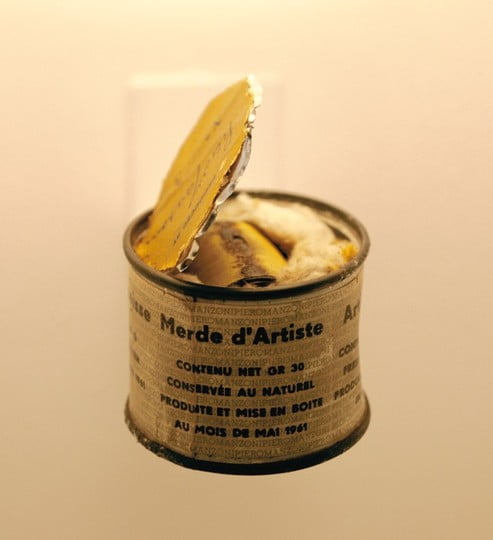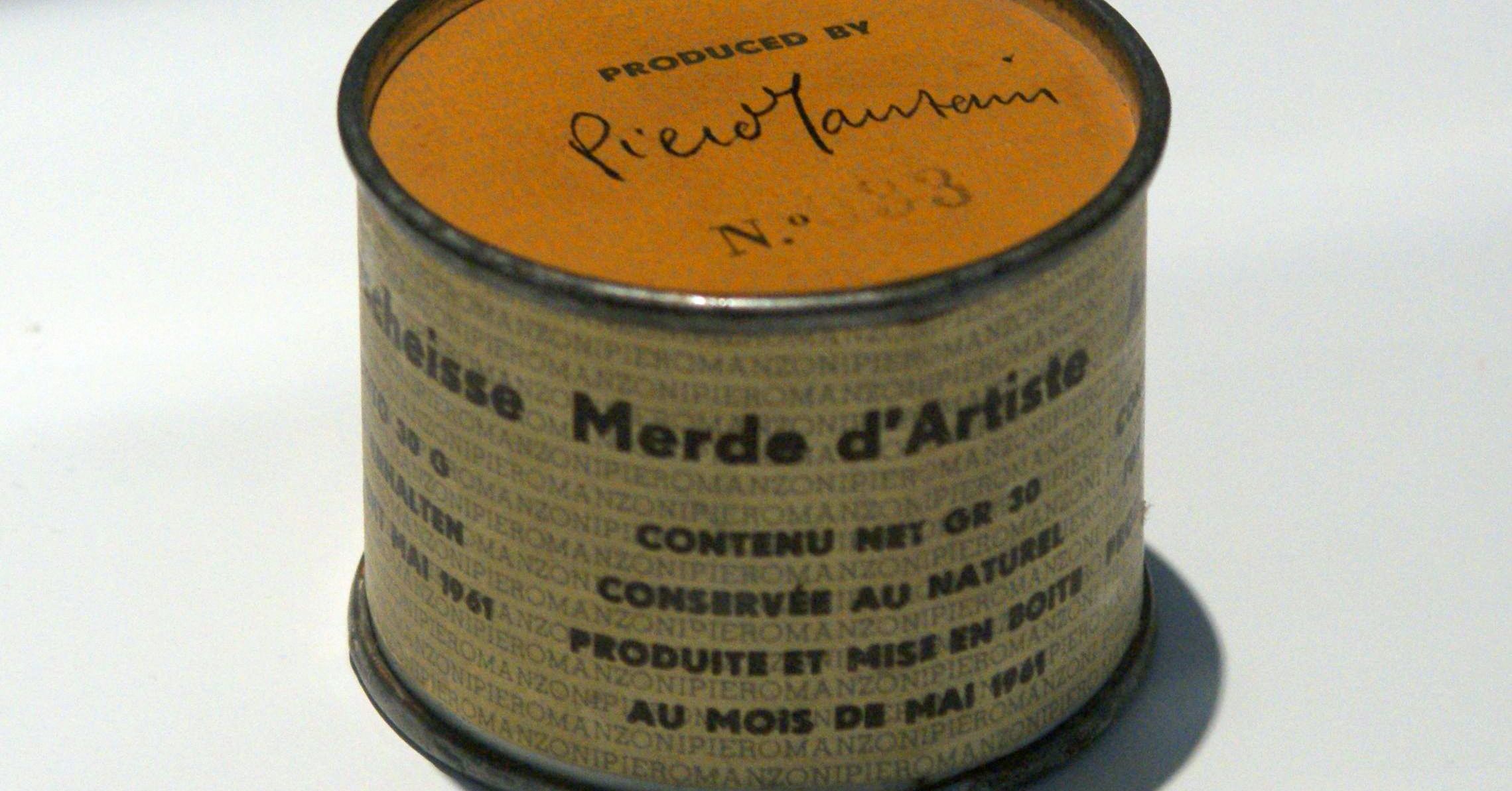The claim that a certain artist sold his feces in jars as works of contemporary art is often cited as an argument to discredit contemporary art. We checked what is behind this story and what exactly the artist was actually selling.
60 years ago, in 1961, Italian conceptualist Piero Manzoni created art objects called “Artist Shit,” sold them and gained worldwide fame. In 2008, the nationalist publicist and philosopher Konstantin Krylov in his blog listed “You are dull shit and a plagiarist, and not a modern artist at all, if...” under paragraph 6 writes: “You make objects or images from feces, urine, blood, semen and banknotes. This shit has already been eaten - and more than once.” TV channel "Tsargrad" mentions this art object in an article with the headline ““Varieties of crap” caused a heated discussion on the air of Andrei Norkin. From laughter to screams” - in fact, about the broadcast of a talk show on NTV. But Komsomolskaya Pravda in the article “Scientific journalist Asya Kazantseva decided to make money by selling her own eggs” ironizes: “It is possible that purchasing Asya Kazantseva’s egg could be a profitable investment. In this regard, I remember the work “Artist’s Shit”, completed in 1961 by the Italian Manzoni.”
The work of art that interests us evokes such a strong storm of feelings and hatred that it can be compared with Malevich’s “Black Square” - by the way, it is also an exhibit of a very respectable age and is still relevant in the minds of the mass audience.
Manzoni's work consisted of 90 tin jars measuring 4.8 by 6.5 cm, the labels of which read “100 percent natural artist's crap” in four languages, as well as a serial number and autograph. By the way, the artist himself said that he was inspired by the words of his father, “Your art is crap!”, and his father owned a cannery. That is, it was a visibly embodied metaphor. Numerous photographs have been taken showing these jars in bulk and in pyramids. Today these photos are reminiscent of Andy Warhol's countless soup cans, but it is curious that the American founder of pop art will come up with your iconic image only for next year.
Manzoni announced that the contents of the jars corresponded to the inscription, and the packaging was 30 g. He then put them up for sale at the price of gold of the same mass. Price of an ounce (28.35 g) of gold that year amounted to approximately $35.5, so one jar initially cost the buyer about $37 - the price was quite affordable for any collector. Whether he managed to sell all 90 jars during his lifetime and where most of them are located is unknown.
The feeling that this “artist’s crap” costs crazy money is associated in the mass consciousness with its prices at auctions. It is logical that over time things become more expensive, especially famous works of art: for example, during the lifetime of a Van Gogh painting sold for a few hundred francs, they now cost hundreds of thousands of dollars. Considering the past years and the accumulated fame of these jars, in 2007–2016 three Manzoni jars were sold at world auctions for amounts ranging from €124,000 to €275,000.
Finally, let's talk about the most disturbing part of the statement that interests us - the contents of the jars. And here very big doubts arise. The fact is that Manzoni was a conceptualist. Conceptualism is an artistic movement, the main tenet of which was that the main thing in art is ideas (and not aesthetics, or edification, or any other goals that art has).
The artistic methods of conceptual art were provocation, all sorts of intellectual twists, humor, deception of expectations and the skill of making the viewer think, comprehend, guess or be deceived. The works of conceptual art were the most amazing. For example, in the same 1961, the famous artist Robert Rauschenberg sent gallery owner Iris Clert, a telegram that read: “This is a portrait of Iris Clert, as I say so.” A year earlier, artist Stanley Brown statedthat all the shoe stores in Amsterdam are nothing more or less than exhibitions of his work.
In today's terms, we can say that the conceptualists of the 1950s–1970s were the real “trolls” of art. Moreover, it’s no match for those of today, because today many are tired of such art, but then the public was not scared.
Thus, Manzoni's work is not the feces themselves, which he (allegedly) put in the jars. The product is that he announced that he had done it. This is a declarative and public shocking, “prank.” For those who bought these cans in 1961, for museums like Tate or Pompidou Centerwho exhibit them today, as well as for those who fight for them at auctions, the actual contents of the jars in terms of chemical composition are of no importance. The object of art here is Manzoni’s act itself, and the jars with inscriptions he made are only a symbol, an emblem of ownership of property. Repeating Manzoni’s act (as well as writing a new “Black Square”) has no artistic value.
Did Manzoni actually put his feces inside the jars? Unknown because most owners have not opened them. Manzoni's feces inside a tin can is a kind of Schrödinger's cat for 20th-century art. If you open it, the work of art will most likely disappear.
The only person who tried to do this publicly was the artist Bernard Basile in 1989. Moreover, he also made a performance out of this, creating a separate work of art called “Open Jar of Piero Manzoni” (Boîte ouverte de Piero Manzoni). Inside, lined with soft material to make it soundless, there was another can, which Basil did not open. Tellingly, the open can has significantly lost in price - in 2006 it was sold at Christie's auction for only €24,000, several times cheaper than the closed products discussed above.

On the other hand, in 1994, jar No. 29 was on display at the Danish Randers Art Museum, where it was loaned by private collector Johan Hunov. Owner accused museum for mishandling the can, as a result of which it began, according to him, to leak. Through the court, he demanded compensation from the museum in the amount of 250,000 Danish kroner. The dispute lasted four years, resulting in concluded a settlement agreement, the details of which the museum did not disclose, except that the can now belongs to the museum.
This means that, most likely, everything is fine with her, otherwise the state museum would not have laid claim to it. Currently the bank presented on the museum’s website among the “masterpieces of the collection” (and it looks great), so as a result of the scandal, the museum acquired both publicity and a rare exhibit. In general, it is impossible to judge the true background of Danish history without having a report from museum restorers (mentioned in the article).
The website of Britain's Tate Modern museum, which houses Jar No. 4, purchased in 2000 for £22,300, carefully describes the exhibit as "a tin can with a paper label and unidentified contents." At the same time, art critic John Miller, who published an article on the museum’s website, writes that the news abounding on the Internet about these banks leaking or exploding are rumors (obviously putting the Danish story in the same category).
Finally, in 2007, the Italian artist Agostino Bonalumi, who worked with Manzoni and was his friend, told newspaper Corriere della Sera that there is only plaster inside.
If there were organic matter inside Manzoni's cans, there would be many more stories like the Danish one in the press. Since these “accidents” would not discredit this exhibit, but, on the contrary, would attract attention to it, which, from the point of view of the owners of the objects who understand their value, is much more important than “keeping the secret about the damaged jar” (such versions are put forward by rumor mongers).
So, the popular online belief that “one contemporary artist was selling his feces for a lot of money” is most likely wrong. The truth looks like this: one representative of the “contemporary art” movement 60 years ago sold a number of tin cans, most likely filled with plaster, for a price quite low for a work of art. However, the words that he uttered and the letters that he wrote made this act (precisely the act) one of the key works of art of the 20th century. Or one of the most memorable jokes.
Most likely not true
- https://journal.bookmate.com/pochemu-dermo-hudozhnika-ehto-shedevr/
- https://www.colta.ru/articles/art/3088-shit-happens
- https://www.tate.org.uk/tate-etc/issue-10-summer-2007/excremental-value
If you find a spelling or grammatical error, please let us know by highlighting the error text and clicking Ctrl+Enter.







